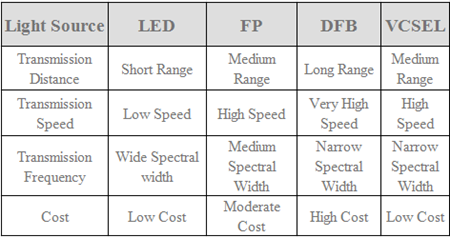To back the changing and fast-growing bandwidth demands of data center, in 2010, the IEEE ratified 40 Gigabit and 100 Gigabit standards, known as IEEE 802.3ba. 40G and 100G Ethernet can be deployed using the same cabling systems today. Both single-mode (SMF) and multi-mode (OM3,OM4) were approved to be utilized in the standard. Multi-mode deploys parallel optics with MPO/MTP interconnects while single-mode fiber will employ serial transmission and use LC or SC connectors. Which cabling options designers should choose for their infrastructure. This article today will provide some practical suggestions to help you make a wise selection. Table 1 shows the comparison between SMF and MMF for 40/100 GbE Implementations.

40GbE Over Multi-mode Fiber
40GbE and 100GbE over multi-mode optics use parallel optics at 10Gbps lasers, simultaneously transmitting across multiple fiber strands to achieve high data rates. Because of the multi-lane nature of these optics, 40GbE multi-mode optics use a different style of fiber cabling, known as MPO or MTP cabling. An MPO/MTP cable presents 12 separate strands of multi-mode fiber in a single ribbon cable. Just as 10GbE optics over multi-mode fiber, an OM3 or OM4 grade MMF is needed to cover longer distances for 40G network.
40GbE and 100GbE over multi-mode optics use parallel optics at 10Gbps lasers, simultaneously transmitting across multiple fiber strands to achieve high data rates. Because of the multi-lane nature of these optics, 40GbE multi-mode optics use a different style of fiber cabling, known as MPO or MTP cabling. An MPO/MTP cable presents 12 separate strands of multi-mode fiber in a single ribbon cable. Just as 10GbE optics over multi-mode fiber, an OM3 or OM4 grade MMF is needed to cover longer distances for 40G network.
OM3 and OM4 MMF are laser-optimized fiber with a core size of 50/125 micron. These 50-micron fibers are optimized for the 850nm transmission of VCSEL-based transceivers. These two fibers have different bandwidths, which results in different achievable lengths for the same transceivers. OM4 fibers, according to the TIA-492AAAD, have higher network reliability and increased design flexibility allowing links with a reach of 150 meters. The IEEE 802.3ba standard specified OM3 fiber with a maximum reach of 100 meters. Take Cisco QSFP-40G-SR4 QSFP+ as an example, it can support a distance of 100m and 150m over OM3 and OM4, respectively. The following image shows a 40G-SR4 and 40GBASE-LR4 QSFP+.

Since we can deploy both OM3 and OM4 MMF for our 40G infrastructure, which one is more suitable? In fact, some senior engineers say that installing either OM3 or OM4 cabling in the data center largely depend on length requirements. They determined that OM4 fiber would substantially extend the reach of next generation networking within the data center and it is able to achieve this greater reach because of its greater EMB over OM3 fiber. OM4 optical fiber enables 40/100G Ethernet to reach an additional 60% of the links in the core-to-distribution and in the access-to-distribution channels when compared to OM3. This should lead to faster market acceptance of 40G/100G Ethernet and OM4 fiber.
40GbE Over Single-mode Fiber
40GBase-LR4 optics use the same multi-lane technology as SR4 optics using four strands for transmit and four strands for receive. But with one exception. Instead of using a single fiber strand for each lane, WDM technology is used to multiplex all four transmit lanes onto one strand of fiber and all four receive lanes onto another single strand of fiber, allowing any existing single-mode fiber installation to be used. Because of this, standard LC (for QSFP modules) or SC (for CFP modules) connections are used, allowing for an easy upgrade from a 10GbE connection. The channel cost for 40GBASE-LR4 is much higher than SR4 optics, which is the main factor that limits its popularity. However, 40GBASE-LR4 like Cisco QSFP-40G-LR4 can reach up to 10km.
40GBase-LR4 optics use the same multi-lane technology as SR4 optics using four strands for transmit and four strands for receive. But with one exception. Instead of using a single fiber strand for each lane, WDM technology is used to multiplex all four transmit lanes onto one strand of fiber and all four receive lanes onto another single strand of fiber, allowing any existing single-mode fiber installation to be used. Because of this, standard LC (for QSFP modules) or SC (for CFP modules) connections are used, allowing for an easy upgrade from a 10GbE connection. The channel cost for 40GBASE-LR4 is much higher than SR4 optics, which is the main factor that limits its popularity. However, 40GBASE-LR4 like Cisco QSFP-40G-LR4 can reach up to 10km.
Conclusion
After going through this article, do you have any idea of choosing which cabling for your 40G network. If you have tight budget and cover a short transmission distance, laser-optimized multi-mode cabling would be the prefect choice. But if you prefer to deploy a high-density long-reach network, single-mode cabling will suit you better. Fiberstore manufactures a large variety of 40G transceivers and cables. You can find what you need here. Please contact us if you are interested.
After going through this article, do you have any idea of choosing which cabling for your 40G network. If you have tight budget and cover a short transmission distance, laser-optimized multi-mode cabling would be the prefect choice. But if you prefer to deploy a high-density long-reach network, single-mode cabling will suit you better. Fiberstore manufactures a large variety of 40G transceivers and cables. You can find what you need here. Please contact us if you are interested.






